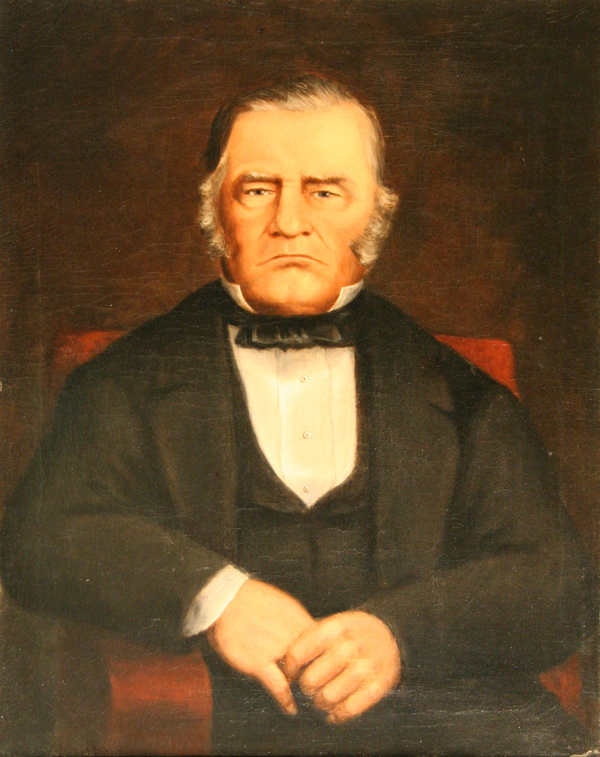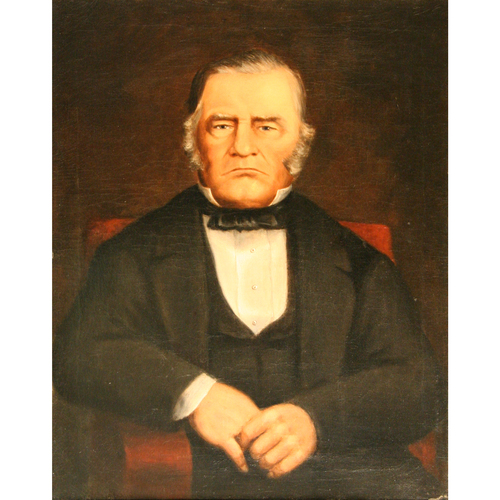
Source: Link
YEO, JAMES, shipbuilder and owner, merchant, landowner, and farmer; b. 1789 (baptized 13 Feb. 1790) at Kilkhampton, Cornwall, England, eldest son of James Yeo and Ann Orsborn; m. first in 1812 Mary Francis, by whom he had three children, and secondly in 1819, Damaris Sargent of Kilkhampton, by whom he had five daughters and two sons; d. 25 Aug. 1868 at Port Hill, P.E.I.
James Yeo, the son of a shoemaker, was a labourer until 1814 or 1815 when he set up as a carter between Kilkhampton and Bideford, Devon. After his first wife’s death in 1818 this business failed, partly as a result of Yeo’s drunkenness. In May 1819 he married again and the couple probably immigrated the same year to Port Hill, Prince County, Prince Edward Island. There Yeo worked as superintendent of the lumbering gangs and helped with the management of the stores in the lumbering, shipbuilding, and mercantile business established by Thomas Burnard in 1818 and at that time managed by Thomas Burnard Chanter*. In 1826, after Burnard’s death, Chanter disposed of the business at Port Hill to William Ellis*, a master shipbuilder who had also emigrated from the Bideford district. The business had a large number of outstanding accounts, many of which Yeo collected in the name of the Burnard family, with whom he was known to be associated; he then retained the proceeds, though they were in fact the legal property of Ellis. In this way Yeo acquired capital to set up on a small scale as a lumber dealer, storekeeper, and owner and master of the 35-foot merchant schooner Mary Ann, which he sailed from 1829 to 1832.
Possessed of enormous physical and mental energy and business acumen, Yeo greatly prospered. By the mid 1830s he already exercised considerable influence in Prince County, having bought the original business at Port Hill from Ellis in circumstances which generated legends of an Esau-like misappropriation of Ellis’ inheritance persisting on the Island to this day.
In 1840 Yeo began shipbuilding on a large scale and soon became the greatest of the Island’s shipbuilders. As such he played a vital part in the colony’s economic development in the middle years of the century, when new ships built for sale in Britain were by far the most important Prince Edward Island export. He was responsible for the construction of at least 155 ships, from the Marina (1833) to the Magdala (completed three days before his death in 1868). Of these, several, especially James Yeo, Palmyra, and William Yeo, were among the largest ships ever built in Prince Edward Island. Yeo’s youngest sons, James and John, and his sons-in-law and their associates built at least another 200 vessels. Many of these ships, launched from sites all around the shores of the Island, were sailed unfinished to Britain for completion at a shipyard established in Appledore near Bideford by James Yeo’s eldest son, William, who returned to Britain in 1843 to act as his father’s principal agent. William Yeo’s position in England was of great importance to his father’s success in shipbuilding; both were also at any one time usually the owners of up to 20 ships sailing with cargoes bound for ports all over the world.
James Yeo had many other business interests, through which his wife and children and brothers and sisters were incorporated into the management of his affairs. He took advantage of the uncertainty of many of the settlers’ titles to send his men to cut timber as long as it lasted; in this way he built up a sizeable export business. Moreover, his stores at Port Hill, ably managed by his wife Damaris, were the largest in the western part of the Island and were operated on a credit basis. Many settlers became indebted to him and through the resulting “power of the Ledger” he was able to exploit their labour and timber. He was also de facto land agent for Sir George Seymour’s holdings in Lot 13, a position that was formalized in 1846, and in 1857 he purchased Seymour’s 16,000 acres, which together with extensive properties already acquired elsewhere in the Island he held for many years.
Yeo also became a large-scale exporter of agricultural products, including oats, potatoes, and livestock, and by the late 1840s was loading ten ships a year for Britain as well as 40 schooners for the neighbouring provinces. A decade later, 11 of his ships, laden with cargoes of lumber and agricultural produce, arrived in British ports within one month. In the 1830s and 1840s relatively little money was in circulation in the colony and it was said that in this period Yeo was the only man in Prince County from whom settlers could obtain cash. He built up a role as financier until by the 1860s he was making large loans to the government. At that time the Islander claimed that his wage bill to his numerous employees alone exceeded the total government revenue. For the last ten years of his life he was frequently referred to in the Island newspapers as the richest man in the colony.
Yeo’s great success was achieved by unflagging energy and ability. He could total figures quickly, and was able to make rapid assessments of the value of timber stands, crops, ships and their cargoes, and business enterprises. He personally supervised his operations, riding on horseback all over the Island and often sleeping in the saddle. A contemporary American visitor once said that “for six months he’s never go to bed.” He was spoken of, even by his admirers, however, as a hard man who retained the rough manners of his youth to the end of his life.
Yeo was first elected to the Island assembly in 1839 as a Conservative member for the first electoral district of Prince County. He remained a member until 1846 when he stood aside to allow the election of James Warburton, later one of his bitterest opponents. About this time he was appointed a justice of the peace. In 1848 he was elected again and sat until he was defeated by 50 votes in 1863. After the election of 1859, when the Conservatives held power by a majority of four, Yeo held a position of particular advantage in the assembly, with control over the votes of his son John and of David Ramsay, a close associate. He undoubtedly used his position to his direct advantage in such matters as the appointment of relatives and associates to offices of influence in local administration. A month after his defeat he was elected to the Legislative Council on which he served until 1867. He was also a member of the Executive Council from 1859 to 1867. During much of his time as a member of the assembly Yeo wielded great influence in Island politics because of his wealth and the power this brought him with his numerous debtors. Contemporaries consequently nicknamed him the “Ledger Baron of Port Hill” and the “Driver of the Government.”
Throughout his long political career, Yeo was concerned principally with practical issues of local administration. In the 1830s he confined himself to such questions as road-building, the issuing of treasury warrants, ferry service, and a custom house at Cascumpec. Lieutenant Governor Charles Augustus FitzRoy* noted that Yeo tended to follow Joseph Pope*’s lead in politics. He could operate his business best under the existing proprietorial system of land ownership, and it is no surprise that his politics were conservative; he was bitterly opposed to the land reforms espoused by William Cooper and the Escheat party, whom Yeo branded “Malignants,” and to the granting of responsible government, as advocated by George Coles* and the Liberals.
James Yeo’s part in the development of shipbuilding, shipping, and the export business in Prince Edward Island in the mid 19th century was unique both in scale and in the breadth and complexity of his operations. For all his ruthlessness he made a material contribution to the economic development of the province and indeed to the merchant shipping industry both in British North America and in Britain at the same period.
After his death in 1868 Yeo’s fortune was split between a number of descendants. His eldest son, William, probably the largest single beneficiary, died four years later without a male heir, and his assets passed into other hands. John Yeo continued his father’s business in P.E.I. with considerable success and enjoyed a long career in the provincial and federal governments, dying a senator in 1924.
[Kilkhampton, Cornwall, Eng., Parish registers, 1790–1819, contain unusually complete records of the births, marriages, and deaths in James Yeo’s complex family. His early career in Prince Edward Island is traceable through PAPEI, P.E.I., Supreme Court records, 1770–1900, and to a small extent through PAPEI, Port Hill papers. His career as shipbuilder and shipowner can be followed in great detail through PAC, RG 42, I, 150–69, 391–93, and National Maritime Museum (London), Reports of Lloyds surveyors of the port of Bideford (mfm. at PAC). His career as a landed proprietor can be followed in PAPEI, P.E.I., Land Registry Office, Land conveyance registers, and there are a number of references to him in Warwick County Record Office (Warwick, Eng.), CR 114A (Seymour of Ragley papers). The activities of his son and agent in Britain, William Yeo, are the subject of numerous references in the North Devon press, notably the North Devon Journal (Barnstable, Eng.), 1840–72. There are also some useful references in Devon County Record Office (Exeter, Eng.), Northam parish registers, 1792–1820. James Yeo’s political life was reported in the Prince Edward Island press, notably the Islander, 1830–68, especially September 1868. Greenhill and Giffard, Westcountrymen in P.E.I., gives a detailed account of Yeo’s career. b.g.]
Cite This Article
Basil Greenhill, “YEO, JAMES,” in Dictionary of Canadian Biography, vol. 9, University of Toronto/Université Laval, 2003–, accessed December 28, 2025, https://www.biographi.ca/en/bio/yeo_james_9E.html.
The citation above shows the format for footnotes and endnotes according to the Chicago manual of style (16th edition). Information to be used in other citation formats:
| Permalink: | https://www.biographi.ca/en/bio/yeo_james_9E.html |
| Author of Article: | Basil Greenhill |
| Title of Article: | YEO, JAMES |
| Publication Name: | Dictionary of Canadian Biography, vol. 9 |
| Publisher: | University of Toronto/Université Laval |
| Year of publication: | 1976 |
| Year of revision: | 1976 |
| Access Date: | December 28, 2025 |



